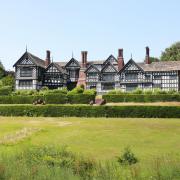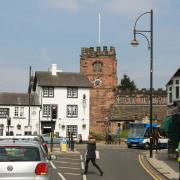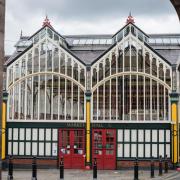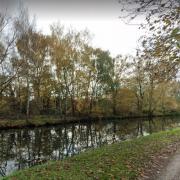Chester breathes history through every cannonball crack and musket ball pockmark in its ancient walls but moves are afoot to enhance further our perceptions of this proud city

For more than 2,000 years, since the battle-hardened Twentieth Legion, Valeria Vitrix, established itself in the Roman fortress commanding the River Dee - the biggest in Britain - Chester has been at the epicentre of epoch-making events.
Today re-enactments featuring patrolling ‘soldiers’ in Roman regalia are familiar sights in the city’s streets and the surviving Roman heritage sites, most famously the 1st Century amphitheatre, are world renowned. Likewise Chester’s magnificent sandstone Cathedral, dedicated to the city’s patron saint, the Mercian princess St Werburgh, the origins of the Mystery Plays and the lay-out of the famous ‘rows’ epitomise the city’s mediaeval importance.
Yet until this summer, one vital period - not only for Chester but which fundamentally changed the nature of the entire country and the world beyond - has, according to local historian Ed Abrams, been neglected.
Ed, born and bred in the city said: ‘I am passionate about the history of Chester and especially its vital role in the English Civil War. Yet you can drive along the A41 and through the battlefield of Rowton Moor - where 10,000 men faced one another in 1645 and 1,000 of them died – without knowing it. There are no obvious signs.’
He is determined to change all that. Ed is the Principal of the newly founded Chester Civil War Tours for which he will dress in period Parliamentary or Royalist uniform and share his enthusiasm on tours featuring the Great Siege of Chester, the Battle of Rowton Moor and the seven 17th Century Chester taverns frequented by Roundheads and Cavaliers alike at various times.
Ed revealed: ‘I spend nearly 20 years as a professional new business salesman for IT companies and I woke up one day in my late 30s and decided I didn’t want to do that any more. I had a chat with my wife, got a flexible job as a taxi driver and went off to university. I graduated from Glendwr University in Wrexham last year with a history degree.
‘I haven’t created anything in Chester; the history is already here. I have just put it on order and wrapped it in a bundle called Civil War Tours. My objective is to tell the story that is living even though these momentous events took place almost 370 years ago and bring it all alive in people’s
imaginations.
‘You can still see the patched up breaches in the walls caused by Parliamentary cannon and look out from the very spot where King Charles I stood and watched his army defeated at Rowton Moor.’
Did you know?
By 1645 Chester was the only remaining English port still in Royalist hands and seen as a vital landing place for loyal troops from Ireland, providing the King’s only hope of avoiding ultimate defeat. After a bloody four month siege and with citizens dying of starvation, William Ince, mayor
of Chester, persuaded the city’s Royalist governor Lord John Byron to surrender to Sir William Brereton’s Parliamentary army in January 1646. Three years later, almost to the day, Charles I was executed.
Pilgrims’ place
Chester Cathedral, a place of pilgrimage for over 1,000 years, and now one of Chester’s major attractions - is about to take its spectacular appeal to a whole new level.
Talked about for some time, the opening of the central tower to the public for the first time since it was built in the 1400s, is about to become a reality with the grant of £1.4m from Cheshire West and Chester council. The Cathedral at Heights project, one of the early stages of the local authority’s ambitious One City Plan, recognises the former Benedictine Abbey’s crucial role both in the social fabric of the city and as a major visitor attraction.
The opening of the tower will enable tourists to explore gallery levels by walking through the ceilings of the north choir aisle and enjoy panoramas from the east end of the cathedral which gives a unique and spectacular viewpoint over the city. With visitor numbers to the cathedral already doubled in the wake of the recent removal of the controversial £5 admission charge (though a voluntary £3 per head donation is requested) Cathedral at Heights is destined to draw
many more when the tour is launched later this year or in early 2014.
Nicholas Fry, Heritage and Visitors Officer at Chester Cathedral, said: ‘The high level galleries will give some amazing views of the interior and close ups of the vaulting. Tourists will go into the old ringing chamber and see the bell frame where the bells used to hang. At the moment work is
continuing on restoring and repairing treads of staircases, putting in handrails and lighting ands providing interpretation exhibits.’
Both the Cathedral shop and the Refectory Cafe have also seen major recent improvements.
Chester footie in the Commons
It’s not often that the exploits of a football club are eulogised in the House of Commons, especially one that went out of business just three years ago. But Chester FC - now owned by its supporters - has not only come back from the dead, but achieved astonishing success.
Stephen Mosley, MP for the City of Chester, asking the Leader of the House for a debate on community football clubs, said: ‘That would allow me to highlight the success of Chester football club, which since being resurrected as a community-owned club in 2010 has won three successive
league titles, regularly attracts over 3,000 fans to home games, has recently been promoted to the Blue Square premier league, and we hope will march on into the Football League next year’.
Club spokesman Jeffrey Banks said: ‘It’s been an amazing journey for everyone at Chester FC. When Chester City FC were liquidated, we had one aim and that was to save football in the City of Chester, it had to happen. We threw every ounce of effort into reforming the club once it became obvious that the former club was not going to survive, and three years on we find ourselves back where Chester City left off, in the Conference Premier. I don’t think any of us expected it to go quite so well, you always have the dream, but in our case the dream has turned into reality.
‘As a community-based football club, we have an amazing team of volunteers that have helped us get where we are, without them I dread to think what we’d all be doing on our Saturday afternoons and the fans deserve great credit for what they have done. So do the management and players at the Club - it’s been an incredible start, with 100 points and 100 goals being achieved in the last two seasons, an incredible statistic. I think Chester FC is a great example of how the fan-ownership model can really work, and I’m sure we’ll see many more clubs following in our footsteps.
‘What we’d like to see of course, is more fans, and new fans at the Club. Cheshire is a huge county, and given the success that we’ve enjoyed so far, we want to try and encourage more people to come and follow Chester FC - to become an owner of the club costs just £1 per month, so please if you haven’t done so already, come and join us!’
Bugs you like
Chester Zoo has just unveiled a jaw-dropping exhibition BUGS! featuring 13 giant animatronic creepy crawlies.
The large-scale robotic replicas of species such a scorpion, a ladybird and a 33ft-wide tarantula, are among the most breathtaking exhibits ever seen in a UK zoo. The huge creations were custom-built by a top animation studio in the USA and their exhibition in Chester is the first time they have ever been seen together, anywhere in the world.
Chester Zoo’s director general, Mark Pilgrim, said: ‘Our work with invertebrates, like our critically endangered Polynesian tree snails or rare British fen-raft spiders, is important to us. We want BUGS! to put invertebrates in the spotlight, show how fantastic they are and really raise awareness of the need to conserve them. Engaging people, particularly youngsters, with conservation sometimes takes some drastic ideas and new ways of thinking and that’s precisely what we hope these 13 giant, robotic bugs will do.’
Culture club aim
Disappointment that Chester failed to make the recent UK City of Culture 2017 shortlist has been replaced by pride in a bid process that galvanised the arts community and promises benefits for years to come. Some 2,000 years after the Romans first laid claim to the title ‘City of Legions’, council chiefs and many cultural and arts organisations vowed to build on the campaign which united their efforts.
Council Leader Mike Jones that Chester is planning its own Roman Centre at the listed Dee House overlooking the amphitheatre.
‘Yes, it was disappointing, but the process helped people realise just how much culture the city already has to offer and sparked a determination by all sorts of organisations to build on the heritage and advanced culture that the Romans introduced all those centuries ago.’ .
While details being suggested for Dee House are still in the early stages, it is visualised that up to 400,000 visitors a year would pay to see a Roman-based high-tech international tourist attraction sitting alongside Britain’s largest amphitheatre. With a capacity of around 8,000, Chester’s amphitheatre would have provided a hub of entertainment and culture in addition to its better known gladiatorial role.
‘It would have staged many cultural events like plays and festivals, military displays and perhaps even wild animals brought from all over the world,’ said Councillor Jones.



























